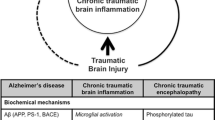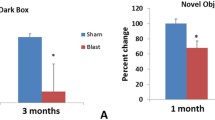Abstract
While it is axiomatic that the major cognitive symptomology of a traumatic brain injury (TBI) of any severity appears shortly after the insult, there is increasing evidence that suggests that, for a subset of individuals with TBI, the course post-injury does not follow what has been traditionally anticipated. Increasingly, longitudinal studies of neurocognitive and neurobehavioral outcomes from TBI demonstrate a highly variable course, which for some continue for a much longer time after the damage associated with TBI lesions would be assumed to have reached a steady state. Chronic neuroinflammatory processes have been identified as one potential source of the continuing decline. We review the literature on chronic inflammatory processes and, in addition, report on the case of a 12-year-old male who sustained a left-temporal lobe displaced skull fracture, with an underlying hemorrhage, when he was hit in the left temporal region of the head by a thrown baseball. Although the youth reported difficulty with memory immediately post-injury, the initial neuropsychological evaluation conducted 6 weeks post-injury yielded data demonstrating that the memory functioning was unaffected by the injury. Testing 3 years later indicated significant memory loss. The course of decline in memory functioning in this instance challenges commonly held conceptualizations concerning the immediacy of memory loss post-TBI and our ability to accurately measure the process as it unfolds.
Similar content being viewed by others
References
Adnan, A., Crawley, A., Mikulis, D., Moscovitch, M., Colella, B., & Green, R. (2013). Moderate–severe traumatic brain injury causes delayed loss of white matter integrity: evidence of fornix deterioration in the chronic stage of injury. Brain Injury, 27(12), 1415–1422. https://doi.org/10.3109/02699052.2013.823659.
Ahmed, S., Bierley, R., Sheikh, J., & Date, E. (2000). Post-traumatic amnesia after closed head injury: a review of the literature and some suggestions for further research. Brain Injury, 14(9), 765–780.
Alexander, D., Shuttleworth-Edwards, A., Kidd, M., Malcolm, C. (2015). Mild traumatic brain injuries in early adolescent rugby players: long-term neurocognitive and academic outcomes. Brain Injury, on line at https://doi.org/10.3109/02699052.2015.1031699.
Assaf, Y., & Pasternak, O. (2008). Diffusion tensor imaging (DTI)-based white matter mapping in brain research: a review. Journal of Molecular Neuroscience, 34(1), 51–61.
Bigler, E. (2012). Neuropathology of mild traumatic brain injury: relationship to neuroimaging findings. Brain Injury and Behavior, 6(2), 108–136. https://doi.org/10.1007/s11682-011-9145-0.
Blatter, D., Bigler, E., Gale, S., Johnson, S., Anderson, C., Burnett, B., et al. (1997). MR-based brain and cerebrospinal fluid measurement after traumatic brain injury: correlation with neuropsychological outcome. American Journal of Neuroradiology Jan, 18(1), 1–10.
Bramlett, H., & Dietrich, W. (2007). Progressive damage after brain and spinalcord injury. Pathomechanisms and treatment strategies. Progress in Brain Research, 161, 125–141.
Brown, J. (1981). The Nelson-Denny reading test: vocabulary, comprehension, reading rate. Forms E and F. Chicago: Riverside.
Carrol, L., Cassidy, J., Peloso, P., Borg, J., von Holst, H., Holm, L.,… Pepin, M. (2004). Prognosis for mild traumatic brain injury: results of the WHO Collaborating Centre Task Force on Mild Traumatic Brain Injury. Journal of Rehabilitative Medicine, Suppl. 43:84–105. https://doi.org/10.1080/16501960410023859.
Chilla, D., Tan, C., Xu, C., & Poh, C. (2015). Diffusion weighted magnetic resonance imaging and its recent trend-a survey. Quantative Imaging in Medical Surgery, 5(3), 407–422. https://doi.org/10.3978/j.issn.2223-4292.2015.03.01.
Cohen, M. (1997a). The Children’s Memory Scales. San Antonio: The Psychological Corporation.
Cohen, M. J. (1997b). Children’s Memory Scale. Administration manual. San Antonio: The Psychological Corporation.
Cole, J., Mitala, C., Kundo, S., Verma, A., Elkinf, J., Nissam, I., & Cohen, A. (2010). Dietary branched chain amino acids ameliorate injury-induced cognitive impairment. PNAS, 107(1), 366–371. https://doi.org/10.1073/pnas.0910280107.
Conners, C., Pitkanen, J., & Rzepa, S. (2011). Conners 3rd edition (Conners 3; Conners 2008). In J. Kreutzer, J. DeLuca, & B. Caplan (Eds.), Encyclopedia of clinical neuropsychology. New York: Springer.
Delis, D., Kramer, J., Kaplan, E., & Ober, B. (2000). California Verbal Learning Test®—second edition. California Verbal Learning Test® (2nd ed.). San Antonio: Pearson.
Dohi, K., Ohtaki, H., Nakamachi, T., Yofu, S., Satoh, K., Miyamoto, K., et al. (2010). Gp91phox (NOX2) in classically activated microglia exacerbate traumatic brain injury. Journal of Neuroinflammation, 7, 41. https://doi.org/10.1186/1742-2094-7-41.
Echemendia, R., Putukian, M., Mackin, R., Julian, L., & Shoss, N. (2001). Neuropsychological test performance prior to and following sports-related mild traumatic brain injury. Clinical Journal of Sport Medicine, 11(1), 22–31.
Erickson, M., & Dohi, K. (2012). Neuroinflammation: a common pathway in CNS diseases as mediated at the blood-brain barrier. Neuroimmunomodulation, 19, 121–130. https://doi.org/10.1159/000330247.
Farbota, K., Sodhi, A., Bendlin, B., McLaren, D., Xu, G., Rowley, H., et al. (2012). Longitudinal volumetric changes following traumatic brain injury: a tensor based morphometry study. Journal of the International Neuropsychological Society, 18, 1006–1018.
Frencham, K., Fox, A., Maybery, M. (2005). Neuropsychological studies of mild traumatic brain injury: a meta-analytic review of research since 1995. Journal of Clinical and Experimental Neuropsychology, 27(3). https://doi.org/10.1080/13803390490520328.
Green, P., Pohling, M., Lees-Hayley, P., & Allen III, L. (2001). Effort has a greater effect on test scores than severe brain injury in compensation claimants. Brain Injury, 15(12), 1045–1060. https://doi.org/10.1080/02699050110088254.
Hooflan, D., Gilboa, A., Vakhil, E., & Donovick, P. (2001). Traumatic brain injury (TBI) 10 20 years later: a comprehensive outcome study of psychiatric symptomatology, cognitive abilities and psychosocial functioning. Brain Injury, 15(3), 189–209. https://doi.org/10.1080/026990501300005659.
Jacobson, L., & Mahone, E. (2011). Wechsler intelligence scale for children. In J. Kreutzer, J. DeLuca, & B. Caplan (Eds.), Encyclopedia of clinical neuropsychology. New York: Springer.
Johnson, V., Stewart, J. E., Beqbie, F. D., Trojanowski, J., & Smith, D. H. (2013). Inflammation and white matter degeneration persist for years after a single traumatic brain injury. Brain, 136, 28–42.
Ledwidge, P., & Molfese, D. (2016). Long-term effects of concussion on electrophysiological indices of attention in varsity college athletes: an event-related potential and standardized low-resolution brain electromagnetic tomography approach. Journal of Neurotrauma, 33(23), 2081–2090.
Lengenfelder, J., Arjunan, A., Chiaravalloti, N., Smith, A., & Deluca, J. (2015). Ssessing frontal behavioral syndromes and cognitive functions in traumatic brain injury. Applied Neuropsychology: Adult, 22(1), 7–15.
Lezak, M. (1983). Neuropsychological assessment (2d ed.). New York: Oxfird Press.
Limond, J., Bull, K., Calaminusc, G., Kennedy, C., Spoudease, H., & Chevignardf, M. (2015). Quality of survival assessment in European childhood brain tumour trials, for children aged 5 years and over. European Journal of Paediatric Neurology, 19(2), 201–210. https://doi.org/10.1016/j.ejpn.2014.12.003.
List, J., Ott, S., Bukowski, M., Lindenberg, R., & Flöel, A. (2015). Cognitive function and brain structure after recurrent mild traumatic brain injuries in young-to-middle-aged adults. Fronteirs in Human Neuroscience. https://doi.org/10.3389/fnhum.2015.00228 on line at http://journal.frontiersin.org/article/10.3389/fnhum.2015.00228/full.
Lockhart, J., & Saty-Murti, S. (2015). Symptom exaggeration and symptom validity testing in persons with medically unexplained neurologic presentations. Neurology Clinical Practice, 5(1), 17–24. https://doi.org/10.1212/CPJ.0000000000000092.
Lowenstiel, D., Thomas, M., Smith, D., & Mcintosh, T. (1992). Selective vulnerability of dentate hilar neurons following traumatic brain injury: a potential mechanistic link between head trauma and disorders of the hippocampus. The Journal of Neuroscience, 12(12), 4846–4853.
Macciocchi, S., Barth, J., Alves, W., Rimel, R., & Jane, J. (1996). Neuropsychological functioning and recovery after mild head injury in college athletes. Neurosurgery, 39, 510–514.
Maudsley, A., Varan, G., Levin, B., Gaurav, G., Leo, H., & Sulaiman, S. (2015). Distributions of magnetic resonance diffusion and spectroscopy measures with traumatic brain injury. Journal of Neurotrauma. https://doi.org/10.1089/neu.2014.3505 on line at http://online.liebertpub.com/doi/abs/10.1089/neu.2014.3505.
McMillian, T., & Teasdale, G. S. (2012). Disability in young people adults after head injury: 12–14-year follow-up of a prospective cohort. Journal of Neurology Neurosurgery Psychiatry, 83, 1086–1091.
Morganti-Kossmann, M., Rancan, M., Stahel, P., & Kossmann, T. (2002). Inflammatory response in acute traumatic brain injury a double edged sword. Current Opinions in Critical Care, 8, 101–105.
Morganti-Kossmann, M., Satgunaseelan, L., Bye, N., & Kossmann, T. (2007). Modulation of immune response by head injury. Injury, 38, 1392–1400.
Ng, K., Mikulis, D., Glazer, J., Kabani, N., Till, C., Greenberg, G., et al. (2008). Magnetic resonance imaging evidence of progression of subacute brain atrophy in moderate to severe traumatic brain injury. Archives in Physical Medicine Rehabilitation, 89, 535–544.
Nies, K., & Sweet, J. (1994). Neuropsychological assessment and malingering: a critical review of past and present strategies. Archives of Clinical Neuropsychology, 9(6), 501–552. https://doi.org/10.1093/arclin/9.6.501.
Numan, B., Sweet, J., & Ranganath, C. (2000). Use of the California Verbal Learning Test to detect proactive interference in traumatic brain injury. Journal of Clinical Psychology, 56(4), 553–562.
Ommaya, A., Goldsmith, W., & Thibault, L. (2002). Biomechanics and neuropathology of adult and paediatric head injury. The British Journal of Neurosurgery, 16, 220–242. https://doi.org/10.1080/02688690220148824.
Pearson. (2009). The Wechsler Memory Scales IV. San Antonio, Texas, United States: Pearson.
Povlishock, J., & Katz, D. (2005). Update of neuropathology and neurological recovery after traumatic brain injury. Journal of Head Trauma Rehabilitation, 20, 76–94.
Prasad, M., & Ewing-Cobbs, L. (2014). Pediatric traumatic brain injury: outcome, assessment, and intervention. In M. Sherer & A. Sander (Eds.), Handbook on the neuropsychology of traumatic brain injury (pp. 311–329). New York: Springer.
Rambo, P., Callahan, J. H., Hellman, S., & Wrape, E. (2015). Effort testing in children: can cognitive and symptom validity measures differentiate malingered performances? Applied Neuropsychology: Child, 4(1), 1–8.
Ransohoff, R. (2016). How neuroinflammation contributes to neurodegeneration. Science, 353(6301), 777–783. https://doi.org/10.1126/science.aag2590.
Rey, A. (1964). The clinical examination in psychology. Paris: University Press of France.
Roberts, R., Mathias, J., & Rose, S. (2014). Diffusion tensor imaging (DTI) findings following pediatric non-penetrating TBI: a meta-analysis. Developmental Neuropsychology, 39(8), 600–637.
Roberts, R., Mathias, J., & Rose, S. (2016). Relationship between diffusion tensor imaging (DTI) findings and cognition following pediatric TBI: a meta-analytic review. Developmental Neuropsychology, 1(3), 176–200. https://doi.org/10.1080/87565641.2016.1186167.
Russo, M., & McGavern, D. (2016). Inflammatory neuroprotection following traumatic brain injury. Science, 353(6301), 783–785. https://doi.org/10.1126/science.aaf6260.
Sheslow, D., & Adams, W. (2003). Wide Range Assessment of Memory and Learning, second edition (WRAML™2). Lutz, Florida, United States: Psychological Assessment Resources.
Shretlen, D., & Shapiro, A. (2003). A quantitative review of the effects of traumatic brain injury on cognitive functioning. International Review of Psychiatry 15 (4) https://doi.org/10.1080/09540260310001606728.
Silber, T., Ahonniska-Assa, J., Levav, M., Eliyahu, R., & Peleg-Pilowsk, A. B. (2015). The effect of age-at-testing on verbal memory among children following severe traumatic brain injury. Child Neuropsychology. https://doi.org/10.1080/09297049.2015.1028348 on line at http://www.tandfonline.com/doi/abs.
Snoek, J., Minderhoud, J., & Wilmink, J. (1984 ). Delayed deteriroration following mild head injury in children. Brain vol, 107(1), 15–36. https://doi.org/10.1093/brain/107.1.15.
Tomaiuolo, F., Bivona, U., Lerch, J., Di Paola, M., Carlesimo, G., & Ciurli, P. (2012). Memory and anatomical change in severe non-missile traumatic brain injury. Brain Research Bulletin, 87, 373–382.
Tsatsanis, K. (2013) Wide Range Assessment of Memory and Learning (WRAML). In V. F.R., Encyclopedia of autism spectrum disorders. NY, New York: Springer.
Vargha-Khadem, F., Gadian, D., Watkins, K., Connelly, A., Van Paesschen, W., & Mishkin, M. (1997). Differential effects of early hippocampal pathology on episodic and semantic memory. Science, 277, 5324. https://doi.org/10.1126/science.277.5324.376,376-380.
Wäljas, M., Iverson, G., Lange Rael, T., Hakulinen, U., Dastidar, P., Huhtala, H., et al. (2015). A prospective biopsychosocial study of the persistent post-concussion symptoms following mild traumatic brain injury. Journal of Neurotrauma, 32(8), 534–547. https://doi.org/10.1089/neu.2014.3339.
Weigner, S., & Donders, J. (1999). Performance on the California Verbal Learning Test after traumatic brain injury. Journal of Clinical and Experimental Neuropsychology, 21(2), 159–170.
Yuh, E., Cooper, S., Mukherjee, P., Yue, J., Lingsma, H., Gordon, W.,… Morabito, D. (2014). Diffusion tensor imaging for outcome prediction in mild traumatic brain injury: a TRACK-TBI study. Journal of Neurotrauma, 31(17), 1457–1477. https://doi.org/10.1089/neu.2013.3171.
Author information
Authors and Affiliations
Ethics declarations
All procedures performed in studies involving human participants were in accordance with the Ethical Standards of the Institutional and/or National Research Committee and with the 1964 Helsinki Declaration and its later amendments or comparable ethical standards.
Informed Consent
Informed consent was obtained from the guardian(s) of all participants included in the study.
Conflict of Interest
The authors declare that they have no conflict of interest.
Appendix
Appendix
Rights and permissions
About this article
Cite this article
Wasserman, T., Mion, A. The Progression of Memory Loss Secondary to TBI-Induced White Matter Attenuation: a Review of the Literature and Case Exemplar. J Pediatr Neuropsychol 5, 31–40 (2019). https://doi.org/10.1007/s40817-018-0050-y
Received:
Revised:
Accepted:
Published:
Issue Date:
DOI: https://doi.org/10.1007/s40817-018-0050-y




